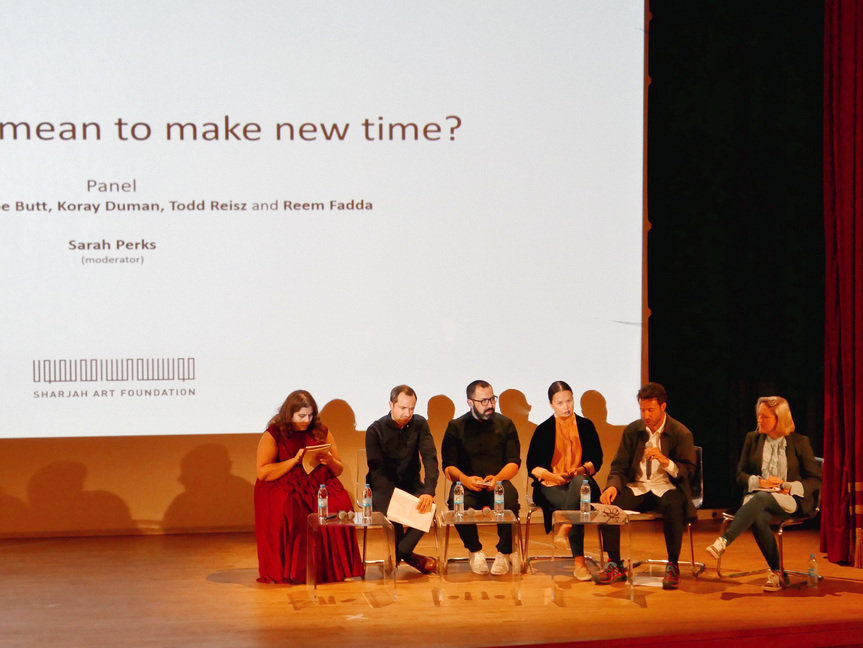
R
E
V N
E
X
T
“Create Dangerously,” convened by Sharjah Biennial 14 (SB14) co-curator Omar Kholeif, capped off the 2019 March Meeting on March 11. Kholeif, whose exhibition project at the biennial was titled “Making New Time,” began the morning with a ruminative poem that featured him buying holiday presents on Amazon.com, and ended his introduction with remarks by his mentor, the late art critic Jean Fischer, on whether art is an effective mediator of change.
Curator Koyo Kouoh and artist Otobong Nkanga were the first speakers of the panel “Africa is not a country; the Middle East is not a continent.” After a long hug with her co-presenter, Nkanga performed a traditional welcoming with a glass of water to summon ancestors. Kouoh informed viewers that she had once been told by one of her mentors that anytime you are invited to speak in public you should talk about whatever you want to talk about, and that she would do exactly that, rather than addressing the lengthy topic of the title, though she asserted that “Africa is certainly not a country and not even a continent for that matter; it is that place, if anything, of essential rituals, endearing rituals, relational rituals, and performed rituals.” Though Kouoh and Nkanga have known one another for a long time—Kouoh said they effectively grew up together over the past 17 years of their careers—they disagreed over several topics. Kouoh placed emphasis on the greeting ritual because she said she couldn’t accept the erasing of that connection even in modern societies, whereas Nkanga was more accepting of changing social graces. Kouoh came around to saying that it was okay with her to think of Africa as a country “in a conceptual way” whereas Nkanga seemed to resist even an ironic acceptance of that way of thinking.
Taking up the second half of the discussion, and without getting too stranded in the geographical parameters of it, Northwestern University professor Hannah Feldman engaged Akram Zaatari about his newly produced film The Landing (2019), shown at SB14. As Zaatari explained, the work features musicians Sharif Sehnaoui, Abed Kobeissy, and Ali Hout, stuck in the modernist housing development Shaabiyat al-Ghurayfah in al-Madam, Sharjah, that has been covered with sand. Over the course of five days, the three figures perform actions in the desert landscape that refer to the late Hassan Sharif’s performances, including his recording of stones, as they attempt to “animate the space.” The film itself, Zaatari explained, folds five days into 63 minutes.
The morning concluded with Tarek el-Ariss’s keynote lecture “Holding time: history, fiction, experience,” which looked at the origins of time in philosophy and literature, from Oedipus Rex, the Quran and Arabian Nights, to St. Augustine’s reflections on memory, the historical subject as conceived by Georg Wilhelm Friedrich Hegel and Sigmund Freud, and by Benedict Anderson, as well as “durée to the virtual”—the trajectory of thought from Henri Bergson to Gilles Deleuze. Ariss then mapped a conception of the past drawn from psychoanalysis (in which revisiting the past is critical to changing the future) onto the context of Lebanon after the Civil Wars ended in 1990, with a quote by former prime minister Rafik Hariri. He also proposed that there are certain figures from mythology, like the ghoul, who can transcend or skirt these conceptions of time, and noted their return in recent television shows and films.
In the afternoon, Kholeif gathered curators Aram Moshayedi (Hammer Museum, Los Angeles), Zoe Butt (SB14 co-curator), and Reem Fadda (Abu Dhabi Department of Culture and Tourism), with architects Koray Duman and Todd Reisz, in a conversation titled “What does it mean to make new time?” moderated by Sarah Perks. Moshayedi talked about the life-long practice of art-making by Huguette Caland, the daughter of Lebanon’s first prime minister, and whose surrealist-inspired paintings are featured in Kholeif’s exhibition. Butt told an anecdote about traveling across China as part of curator Lu Jie’s Long March Project, and his incredible attention to small moments rather than the outside world. Reisz’s work looks at infrastructure development in Dubai, marking time in terms of investment rates, loan periods, development, and poured concrete. Fadda made a passionate case for artists to attempt to materialize time, rather than refer to it as an abstraction, so that it can be given back to people, citing a graffiti-like canvas by Shakir Hassan al-Said, who founded the One Dimension Group in 1971.
“I miss my pre-internet brain,” and “I like that there’s no shopping in Game of Thrones,” Douglas Coupland remarked as he read what was billed as a manifesto—though it was more ruminative than polemic—about longing for older forms of time, before smart phones and the internet. Following Coupland was another writer, Cairo-based novelist and essayist Yasmine el-Rashidi, who compared the conception of time held by a writer like herself to those who work in contemporary art. She noted that, for example, there is no equivalent term in literature to “contemporary art”—no “contemporary writing” or “contemporary literature.”
Finally, Fatima al-Qasimi’s closing keynote, “The imagination in the thought of Ibn Al-Arabi,” was an interesting if very dense analysis of a complex concept in the 12th-century writer’s 100 surviving texts, where he wrote about his belief that imagination is a “realm lying between the two worlds of the Earth and Heaven.”
HG Masters is the deputy editor and deputy publisher of ArtAsiaPacific.
To read more of ArtAsiaPacific’s articles, visit our Digital Library.


















